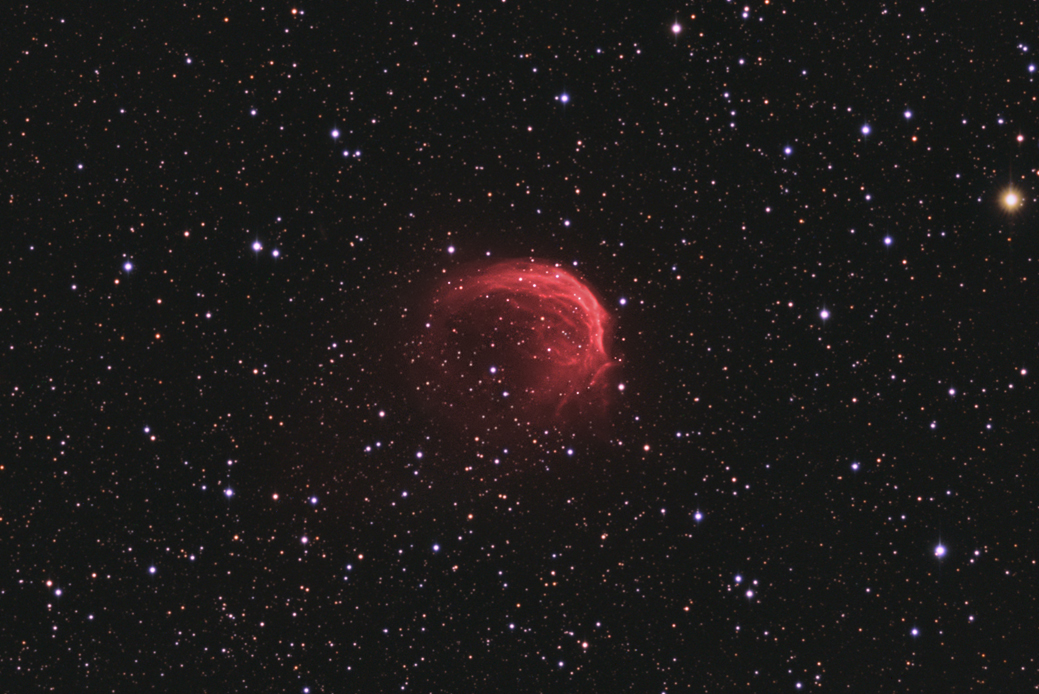Planetary Nebula SH2-188
Characteristics:
Size: Diameter of the brightest arc is about 10'.
Distance: ?
RA: 01h 30m 33s
Dec: 58 degrees 24' 51"
Description:
SH2-188 is a planetary nebula in Cassiopeia. It was first
photographed in 1965 and was initially thought to be a supernova
remnant, in part due to its asymmetric crescent-like shape.
However, this object is now known to be a planetary nebula, which is
consistent with the abundance of carbon, nitrogen, and oxygen in its
outer shell. Unlike SH2-188, however, most planetary nebulae have
a symmetric shell that expands outward from its dying star.
Examples include the Ring Nebula, the Helix Nebula, and the Bubble
Nebula, to name a few. When a dying star between 1-5 solar masses
finally exhausts helium in its core, it enters into the Asymptotic
Giant Branch (AGB) of the HR diagram, where it becomes a red giant
again (but now burning helium to carbon in its outer layers).
During this AGB phase, it expels relatively slow moving gas into
space. Eventually the star shrinks, becomes hotter, and expels
gas at a much faster rate. This faster moving solar wind
catches up and collides with the slower moving gas from the prior
AGB phase, forming a bow shock. The bow shock region typically
forms a symmetric shell of compressed gas that is excited by UV
emission from
the central star. This mechanism of PN formation is known as the
"Interacting Stellar Winds" model and nicely explains the shape of most
PN, except for SH2-188...
So why is SH2-188 so asymmetric? Another model has been proposed
to explain this, in which the rapidly moving PN interacts with the
interstellar medium (ISM). As a result of this interaction, the
bow shock is preserved in the direction of forward motion, but the back
end of the PN essentially drags behind and eventually dissipates
away. In my image of SH2-188 shown above, the forward
crescent shaped arc is easily seen, but there is a fainter portion at
the back end that closes the loop, associated with a poorly-defined
triangular trail of gas that emits in Ha. This region is
unmistakable when processing this image, and is more easily seen on my Ha image used as
luminance. I have also inverted this image as another means
of appreciating this faint
region. My understanding of the processes involved in
shaping SH2-188 comes largely from these two articles (Wareing et al 2004, Wareing
et
al 2005), which I recommend for further reading.
Photographic Details:
Date: August 30 and 31, 2006
Scope: Takahashi
FS102 at f6, on the G11 Losmandy
Mount.
Autoguider: SBIG STV with
e-finder.
Camera: Maxcam CM10.
Filter: Astronomik
Ha filter (6 nm bandpass); RGB type II filter set.
Exposures: Ha: 18 x 10'
each.
R and G, 6 x 5' each; B, 6 x 8' each. All unbinned. Total
exposure: 4.8 hours.
Conditions: Temperature 60 degrees F; below average
transparency due to intermittent high, thin clouds; average seeing;
calm.
Post-processing:
This is an Ha(HaR:G:B) image. Debloomed
with Ron Wodaski's
Debloomer software, followed by calibration and alignment in
Maxim.
Sigma combined using RC Sigma Reject
MaximDL, followed by DDP
in ImagesPlus (IP). Further processing in Photoshop CS (16
bit format). The Ha contribution to the
red channel and to luminance was restricted to the planetary nebula
region by using a mask in PS. In this way, I was able to
preserve the deep color and stellar profiles throughout the rest of the
FOV (i.e., the RGB components), without interference from the Ha
luminance channel.
Please
note: Graphics on this website
may not be reproduced without author permission.
Back to Nebulae
Home

